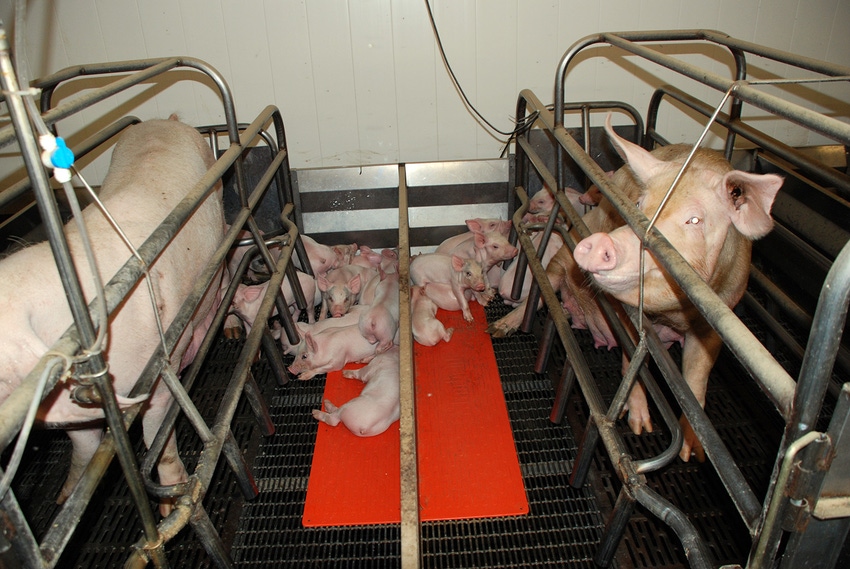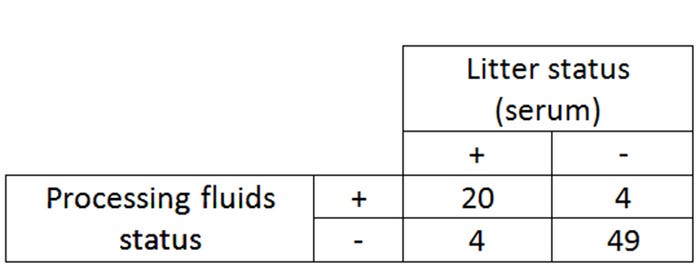Using processing fluids as a diagnostic tool can help us to detect lower PRRS prevalence in the herd.
December 12, 2017

By Carles Vilalta, Juan Sanhueza, Montse Torremorell and the late-Bob Morrison, University of Minnesota
During the last few years, the improvement of sampling and diagnostics techniques has made sampling on the farm an easier task. The use of blood pooling techniques and oral fluids are two examples of those improvements.
However, veterinarians and producers are always looking for more sensitive, cheaper and quicker techniques for sampling herds. One of the ways of achieving these goals would be to use routine chores, such as piglet processing, since castration and tail docking are part of the regular procedures in sow farms.
We propose to use the processing fluids, the liquid accumulated at the bottom of the pail when farmers collect tails and testicles during routine procedures as a sample. The goal of this study was to evaluate the accuracy of the processing fluids by real-time polymerase chain reaction to assess porcine reproductive and respiratory syndrome virus status in a sow herd.
Sampling took place after an outbreak in a farm that was provisionally negative. Ten litters per week from different parities were selected and sampled at processing (three days) during eight consecutive weeks. Litters were conveniently selected in order to have a good spatial representation of the room and parities. All piglets of the selected litters were bled and tested in order to use that as the gold standard comparative sample. Testicles and tails from each litter were placed in a Ziploc bag. The tissues remained in the bag for at least two hours. Afterwards the fluid was removed with a sterile pipette and placed in a sterile serum tube. Both, blood and processing fluids were centrifuged at the farm and transported to the lab under refrigeration. All samples were tested by real-time RT-PCR.
A 2x2 table (Figure 1) was built comparing serum status and processing fluid status. A litter was considered positive if at least one of its piglets was positive in serum. Positives were categorized based upon a negative Ct value threshold lowered to 37.5 instead of the conventional 40 Ct, in order to include in the analysis samples that were in the suspect range, 35 to 40 Ct. Sensitivity (95% confidence interval) and specificity (95% confidence interval) of the technique were 83% (63-95%) and 92% (82-98%), respectively. The agreement between both types of sampling was good (Kappa: 0.76 [95% confidence interval: 0.53-0.98%]). Four false positives and four false negatives were detected. The serum of the piglets in the false negative had a low virus load (high Cts) and when those were diluted the Ct of those samples fell in the negative range. Even though the transfer of the processing fluids was made with extreme care some cross contamination might have been possible as we observed four false positive results.

Figure 1: Table 2x2 of the litter status using the serum as a golden standard.
Keypoints:
• Using processing fluids as a diagnostic tool can help us to detect lower PRRS prevalence in the herd.
• Testicles and tails should be collected in a pail as they are potential spreaders of PRRS in the farrowing room
• We should target young parity sows for PRRSV sampling
There was a statistical difference (p<0.05) between the percent of positive processing fluids when comparing low-parity groups (first and second farrow) versus high-parity groups (more than second farrow) being the lower parities the ones with higher percentage of positives animals. This is in agreement with what Cano et al. (2008) found when trying to identify risk indicators associated with a higher probability of detection of PCR-positive piglets.
Processing fluids showed to be positive even though only one piglet in the litter was positive showing that the processing fluids are a very sensitive tool to capture what is happening in the litters, and therefore in the herd. At the same time these results highlight the importance of collecting testicles and tails in order to reduce the dissemination of the disease. Additionally, it was possible to recover and sequence PRRSV from the processing fluids specimen.
One limitation of this study is that only samples from one farm are represented, and thus further studies may be needed in order to evaluate the external validity of our results.
In conclusion, processing fluids are an effective sample to detect PRRSV in piglets, even after a significant time since the outbreak (~ six months), especially in litters from young parity sows.
You May Also Like



